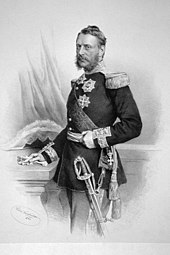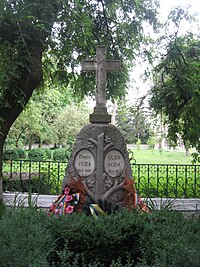Alexandru Ioan Cuza

Alexandru Ioan Cuza ( , known as Prince Alexandru Ioan I ; * March 8th July / March 20th 1820 greg. In (according to different statements) Huși or in the village of Barboși (today's municipality of Hoceni ), then Moldova , today Romania ; † May 15, 1873 in Heidelberg ) was the founder and first prince of the Principality of Romania (1859–1866).
Life
Cuza went to school in Iași (Jassy) and completed the Baccalauréat in Paris in 1835 , where he began to study law. Without finishing it, he returned to Moldova and joined the army. In 1844 he married Elena Cuza . In 1848 he took part in the uprising and then fled to Transylvania. In 1849 he returned and became head of the Covurlui district. In 1851 Cuza was appointed Ministerial Director in the Ministry of the Interior. In 1857, Cuza was elected as a representative of the city of Gala undi and Minister of War the following year.
In January 1859, Cuza was elected Prince of Moldavia and a few weeks later, on January 24th (national holiday, Day of Unity), Prince of Wallachia , laying the foundation for what would later become Romania. At first, however, there was resistance from some great powers, especially from Austria and the Sublime Porte ( Ottoman Empire ) until the double election was recognized in September 1859. On December 24, 1861, under the sovereignty of the Ottoman Empire, he proclaimed the state of România with the capital Iași, which was replaced by Bucharest a year later - after the two countries had also been formally united .
Following the French model, he and his Prime Minister Mihail Kogălniceanu began to modernize the country and reorganize the land ownership. In doing so, he drew the displeasure of local church princes and the nobility , but also resistance from Russia and the Ottoman Empire . His opponents wanted to reverse the union of the two principalities. The solution should be to appoint a European prince to the throne. A conspiratorial group of military entered in the early morning hours of February 11th . / February 23, 1866 greg. entered the palace and forced the prince to abdicate . In the days that followed, he was taken out of the country across the border.
Now space was free for the successor Karl von Hohenzollern-Sigmaringen , who was officially promoted to the new prince on March 26, 1866.
After that, Cuza lived in exile in Paris and later in Vienna. Due to illness he traveled to Heidelberg in Baden to see a specialist, but he died on May 15, 1873 in Heidelberg. He was buried in the Biserica Domnească in Ruginoasa . According to his wishes, his bones were reburied in the Biserica Trei Ierarhi in Iași after the Second World War .
Honors
front of the legal seminar
On July 3, 2011, the unveiling of the bust of Alexandru Ioan Cuza took place in the Heidelberg City Garden. The bust, the work of the sculptor Constantin Ionescu, is a gift from the Prahova district and the Prahova Museum of Archeology and History to the city of Heidelberg.
A bronze statue of the prince stands in a small green space in Bucharest, which forms an entrance to the Patriarchal Cathedral . In the Romanian capital, a park was named after the founder of the state, or Parcul IOR . The university in Iași is also named after him.
See also
literature
- Dionisie Ghermani: Cuza, Alexandru Ioan , in: Biographical Lexicon for the History of Southeast Europe . Vol. 1. Munich 1974, pp. 349-352
Web links
- Literature by and about Alexandru Ioan Cuza in the catalog of the German National Library
- Entry in the Enciclopedia României (Romanian)
Individual evidence
- ↑ Biography , Romania creatorilor (Romanian)
- ↑ George Ioan Lahovari: Marele dictionar geografic al Romaniei , Volume 1, Bucharest 1898
- ↑ cuzagesellschaft , inauguration of the bust of Alexandru Ioan Cuza in Heidelberg , accessed September 11, 2011
- ↑ Illustration of the statue of Ion Cuza in Bucharest
- ↑ A video with a view of the park on YouTube , published November 6, 2016, accessed March 29, 2018.
| predecessor | Office | successor |
|---|---|---|
|
Barbu Dimitrie Știrbei ( Wallachia ) IA Cantacuzino , Vasile Sturdza , Anastasie Panu ( Moldau ) |
Prince of Romania 1859–1866 |
Charles I. |
| personal data | |
|---|---|
| SURNAME | Cuza, Alexandru Ioan |
| ALTERNATIVE NAMES | Alexandru Ioan I .; Cuza, Alexander |
| BRIEF DESCRIPTION | Romanian founder and prince |
| DATE OF BIRTH | March 20, 1820 |
| PLACE OF BIRTH | Huși , Moldova |
| DATE OF DEATH | May 15, 1873 |
| Place of death | Heidelberg |






